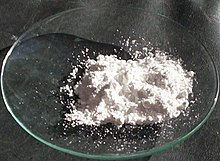Application of the titanium
Applications
Titanium is used in steel as an alloying element (ferro-titanium) to reduce grain size and as a deoxidizer, and in stainless steel to reduce carbon content. Titanium is often alloyed with aluminium (to refine grain size), vanadium, copper (to harden), iron, manganese, molybdenum, and with other metals.Applications for titanium mill products (sheet, plate, bar, wire, forgings, castings) can be found in industrial, aerospace, recreational, and emerging markets. Powdered titanium is used in pyrotechnics as a source of bright-burning particles.
Pigments, additives and coatings
About 95% of titanium ore extracted from the Earth is destined for refinement into titanium dioxide (TiO2), an intensely white permanent pigment used in paints, paper, toothpaste, and plastics. It is also used in cement, in gemstones, as an optical opacifier in paper, and a strengthening agent in graphite composite fishing rods and golf clubs.
TiO2 powder is chemically inert, resists fading in sunlight, and is very opaque: this allows it to impart a pure and brilliant white color to the brown or gray chemicals that form the majority of household plastics.In nature, this compound is found in the minerals anatase, brookite, and rutile.Paint made with titanium dioxide does well in severe temperatures, and stands up to marine environments. Pure titanium dioxide has a very high index of refraction and an optical dispersion higher than diamond.In addition to being a very important pigment, titanium dioxide is also used in sunscreens due to its ability to protect skin by itself. Recently, titanium oxide has been put to use in air purifiers (as a filter coating), or in film used to coat windows on buildings so that when titanium oxide becomes exposed to UV light (either solar or artificial) and moisture in the air, reactive redox species like hydroxyl radicals are produced so that they can purify the air or keep window surfaces clean.
Aerospace and marine
Due to their high tensile strength to density ratio,high corrosion resistance,fatigue resistance, high crack resistance,and ability to withstand moderately high temperatures without creeping, titanium alloys are used in aircraft, armor plating, naval ships, spacecraft, and missiles.For these applications titanium alloyed with aluminium, vanadium, and other elements is used for a variety of components including critical structural parts, fire walls, landing gear, exhaust ducts (helicopters), and hydraulic systems. In fact, about two thirds of all titanium metal produced is used in aircraft engines and frames.The SR-71 "Blackbird" was one of the first aircraft to make extensive use of titanium within its structure, paving the way for its use in modern military and commercial aircraft. An estimated 59 metric tons (130,000 pounds) are used in the Boeing 777, 45 in the Boeing 747, 18 in the Boeing 737, 32 in the Airbus A340, 18 in the Airbus A330, and 12 in the Airbus A320. The Airbus A380 may use 77 metric tons, including about 11 tons in the engines. In engine applications, titanium is used for rotors, compressor blades, hydraulic system components, and nacelles. The titanium 6AL-4V alloy accounts for almost 50% of all alloys used in aircraft applications.
Due to its high corrosion resistance to sea water, titanium is used to make propeller shafts and rigging and in the heat exchangers of desalination plants; in heater-chillers for salt water aquariums, fishing line and leader, and for divers' knives. Titanium is used to manufacture the housings and other components of ocean-deployed surveillance and monitoring devices for scientific and military use. The former Soviet Union developed techniques for making submarines largely out of titanium.
Industrial
Welded titanium pipe and process equipment (heat exchangers, tanks, process vessels, valves) are used in the chemical and petrochemical industries primarily for corrosion resistance. Specific alloys are used in downhole and nickel hydrometallurgy applications due to their high strength (e. g.: titanium Beta C alloy), corrosion resistance, or combination of both. The pulp and paper industry uses titanium in process equipment exposed to corrosive media such as sodium hypochlorite or wet chlorine gas (in the bleachery). Other applications include: ultrasonic welding, wave soldering, and sputtering targets.
Titanium tetrachloride (TiCl4), a colorless liquid, is important as an intermediate in the process of making TiO2 and is also used to produce the Ziegler-Natta catalyst, and is used to iridize glass and because it fumes strongly in moist air it is also used to make smoke screens.
Consumer and architectural
Titanium metal is used in automotive applications, particularly in automobile or motorcycle racing, where weight reduction is critical while maintaining high strength and rigidity.The metal is generally too expensive to make it marketable to the general consumer market, other than high-end products, particularly for the racing/performance market. Late model Corvettes have been available with titanium exhausts.
Titanium is used in many sporting goods: tennis rackets, golf clubs, lacrosse stick shafts; cricket, hockey, lacrosse, and football helmet grills; and bicycle frames and components. Although not a mainstream material for bicycle production, titanium bikes have been used by race teams and adventure cyclists.Titanium alloys are also used in spectacle frames. This results in a rather expensive, but highly durable and long lasting frame which is light in weight and causes no skin allergies. Many backpackers use titanium equipment, including cookware, eating utensils, lanterns, and tent stakes.Though slightly more expensive than traditional steel or aluminium alternatives, these titanium products can be significantly lighter without compromising strength. Titanium is also favored for use by farriers, since it is lighter and more durable than steel when formed into horseshoes.




